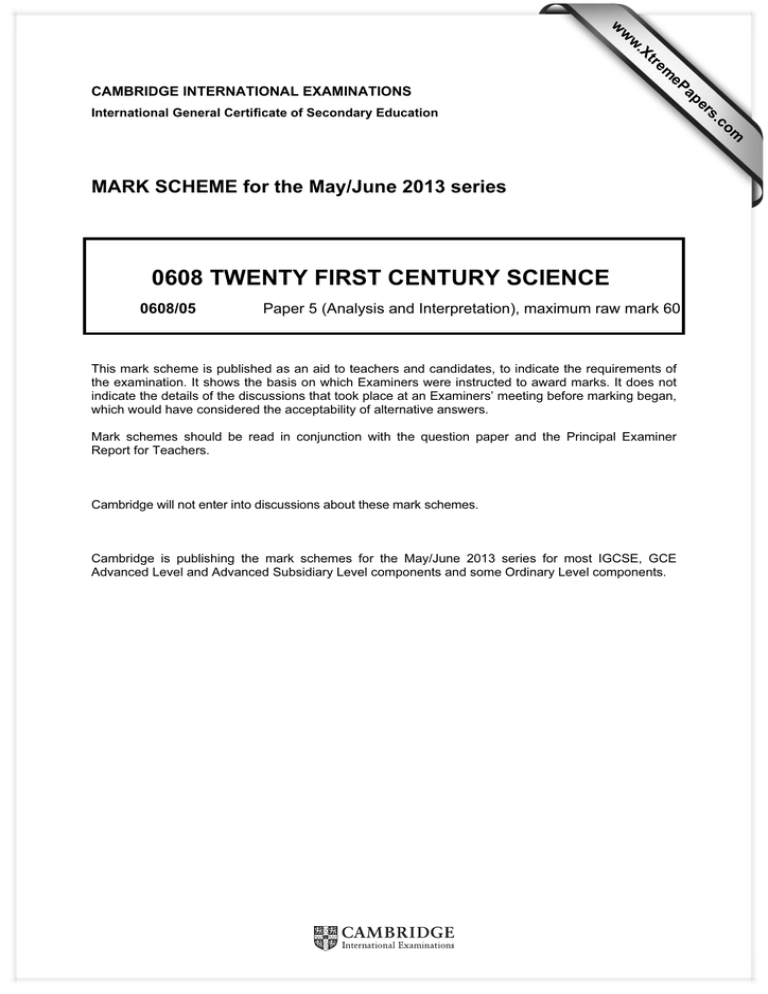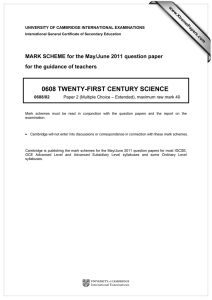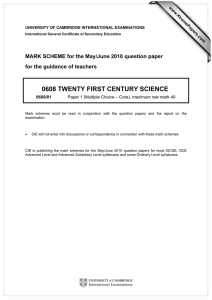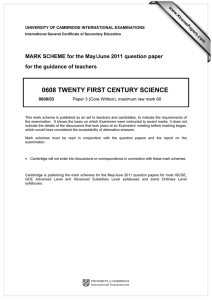0608 TWENTY FIRST CENTURY SCIENCE
advertisement

w w ap eP m e tr .X w CAMBRIDGE INTERNATIONAL EXAMINATIONS 0608 TWENTY FIRST CENTURY SCIENCE 0608/05 Paper 5 (Analysis and Interpretation), maximum raw mark 60 This mark scheme is published as an aid to teachers and candidates, to indicate the requirements of the examination. It shows the basis on which Examiners were instructed to award marks. It does not indicate the details of the discussions that took place at an Examiners’ meeting before marking began, which would have considered the acceptability of alternative answers. Mark schemes should be read in conjunction with the question paper and the Principal Examiner Report for Teachers. Cambridge will not enter into discussions about these mark schemes. Cambridge is publishing the mark schemes for the May/June 2013 series for most IGCSE, GCE Advanced Level and Advanced Subsidiary Level components and some Ordinary Level components. om .c MARK SCHEME for the May/June 2013 series s er International General Certificate of Secondary Education Page 2 Question 1 (a) Expected Answers Syllabus 0608 Mks any two from: show features of living things / what they looked like ; reference to changes over time ; fossils can be dated ; [2] two or more species are directly descended from a common ancestor ; [1] (ii) have features of apes and monkeys ; [1] (iii) any two from: more fossils ; fossils of different ages ; fossils from different areas ; different bones (other than skull) ; [2] 28 million years ago ; [1] would suggest monkey and apes diverged even earlier / more than 28 million years ago ; (the new skull) provides scientists with new data / makes original prediction less reliable / AW ; [2] Australopithecus ; [1] (b) (i) (c) (i) (ii) (d) (i) (ii) (e) Mark Scheme IGCSE – May/June 2013 any two from: environmental change / specific example of environmental change ; (new) predator ; (new) competitors ; (new) disease ; Paper 05 Additional Guidance allow ‘monkeys and apes both evolved from Saadanius’ allow reference to DNA evidence do not allow reference to human activities [2] allow description of variation between individuals mutation / variation ; some better adapted (to environmental change) ; pass on alleles/trait to offspring ; [3] allow natural selection (1) if no other marks awarded [Total: 15] © Cambridge International Examinations 2013 Page 3 2 (a) (b) (i) (ii) (c) (i) (ii) Mark Scheme IGCSE – May/June 2013 Syllabus 0608 two concentric circles within given circle: inner zone labelled ‘core’ ; mantle and crust correctly labelled ; [2] any two from: no evidence (of movement) ; no known mechanism for movement ; idea proposed by an outsider ; old theories worked well ; reluctance to abandon accepted ideas ; [2] any two from: magma erupts in mid-ocean ; seafloor becomes larger ; pushes on continents ; continents ‘float’ on the mantle ; movements in mantle move continents ; [2] ground shaking / earth movements lead to buildings cracking / collapsing / AW ; [1] build lower buildings / build buildings out of stronger materials ; [1] (d) (e) (i) (ii) suggestion: set up emergency procedures / train public in safe behaviour ; explanation: to provide relief more rapidly / to reduce casualties ; [2] idea of continual / regular measuring ; sudden radon increase indicates rock movement / earthquake imminent ; [2] day 7 is the highest reading / is a big increase ; other readings vary considerably / don’t really show a trend ; 27 is no further from mean than 18 / 26 & 27 are similar ; [3] Paper 05 allow details of rubber bearings / oscillating counterweights [Total: 15] © Cambridge International Examinations 2013 Page 4 3 (a) (i) (ii) (b) Mark Scheme IGCSE – May/June 2013 Syllabus 0608 43 ; [1] 7; [1] allow reverse argument as the distance increases ; the acidity decreases / the alkali used decreases ; (c) (d) (i) (ii) (e) Paper 05 [2] allow negative correlation (1) if no other marks awarded use indicator / pH meter ; colour change / shows pH 7 ; [2] allow green measuring cylinder with finer divisions/ burette ; [1] can judge to 0.1 cm3 / smaller bore gives more distance for each unit of volume ; [1] can identify/eliminate outliers ; can calculate an average/mean/best estimate of true value ; [2] allow pipette [Total: 10] 4 (a) any three from: record number of counts per minute ; repeat for that rock and take average ; repeat for each different rock ; measure background radiation (with no rock present) ; subtract background radiation from the readings (for each rock) ; (b) any two from: rocks not all same size ; distance from centre of block varies ; some radiation will miss detector ; block itself will absorb radiation ; (c) [3] allow shape [2] E less radioactive than A ; not possible to compare others ; [2] (d) (i) (ii) way of changing temperature of rock (e.g. oven, water bath, freezer) / thermometer ; [1] any two from: record temperature and corresponding count rate ; repeat count readings for that temperature (to get average) ; repeat at different temperatures ; [2] allow idea that B gives out a lot of radiation despite being a very small sample allow either [Total: 10] © Cambridge International Examinations 2013 Page 5 5 (a) Mark Scheme IGCSE – May/June 2013 Syllabus 0608 ignore reference to time any two from: (same) plastic dish ; (same) woodlouse ; ignore number of woodlice (same) temperature ; (same) light ; (same) amount/thickness / type of cotton wool ; (b) (c) (d) Paper 05 do not allow cotton wool unqualified [2] 5.5 ;; suitable scale using more than half vertical space ; [2] if incorrect: allow 6 + 5 (1) 2 allow 4 (best estimate without removing outlier) (1) [1] likely to be 1 cm (on axis) per cm travelled (by woodlouse) points plotted correctly ± half square ;;; all correct = 3 4 correct = 2 3 correct = 1 [3] (e) ruled straight line ; [1] (f) correct extrapolation shown on their graph ; [1] allow ecf from part (b) allow ecf if line not ruled in (e) [Total: 10] © Cambridge International Examinations 2013


